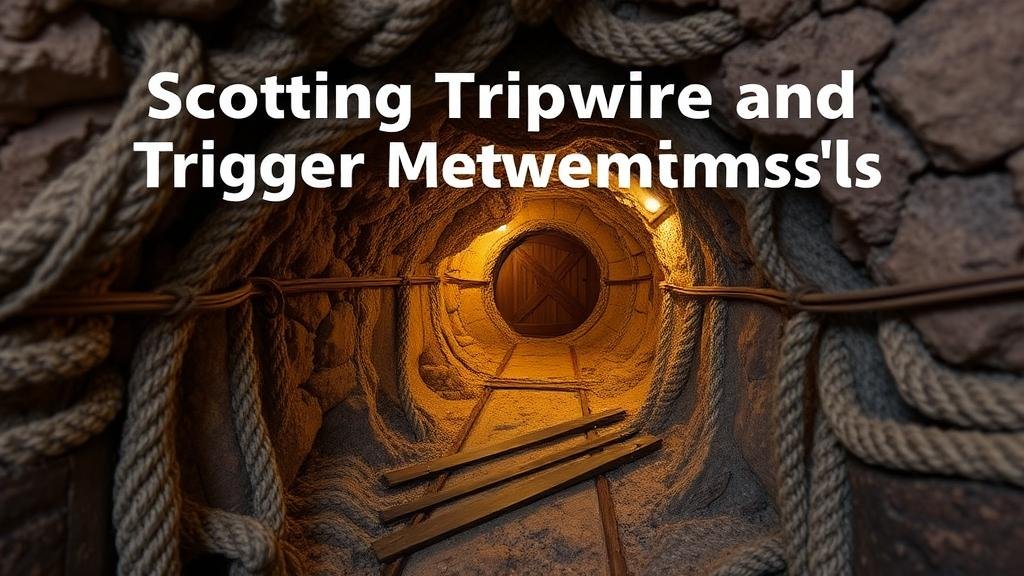Spotting Tripwire and Trigger Mechanisms in Narrow Treasure Tunnels
Spotting Tripwire and Trigger Mechanisms in Narrow Treasure Tunnels
The exploration of treasure tunnels has captivated treasure hunters and archaeologists alike for centuries. Central to these pursuits is the understanding of the various mechanisms used to protect hidden treasures. Among these, tripwires and trigger mechanisms serve as both practical and psychological deterrents. This article delves into how to identify these mechanisms within narrow treasure tunnels, the technology behind them, and how understanding these elements can enhance safety and efficacy in treasure hunting endeavors.
Understanding Tripwire Mechanisms
Tripwires are one of the simplest yet most effective forms of security, used historically to protect treasures from unauthorized access. A tripwire typically consists of a thin, often nearly invisible wire strung across a tunnel, which, when tripped or disturbed, activates a reaction that can range from an alarm to a lethal trap. Knowing how to spot these mechanisms is crucial for anyone exploring narrow passages.
Typical indicators of a tripwire may include:
- Unusual or taut lines running across the tunnel entrance or along the walls.
- Significant disturbances in the surrounding area, such as disturbed dust or debris.
- Unusual markings or outlines on the ground depicting prior disturbances.
For example, in a study conducted in South America, archaeologists found numerous ancient burial sites secured with tripwires. e tripwires were often reinforced with natural materials, making them more challenging to detect. Early detection relies on recognizing any odd changes in the surroundings.
Trigger Mechanisms: Types and Functions
Trigger mechanisms encompass a broader array of devices that activate traps or alarms upon disturbance. They can be sophisticated, employing mechanical components, or simple, using natural elements. Understanding their categorization is essential for pinpointing potential hazards.
- Mechanical Triggers: These often involve levers or pulleys that activate when weight is applied to a tripwire. For example, a tripwire connected to a counterweight could release a heavy object, causing it to fall onto an intruder.
- Pneumatic Systems: Utilizing air pressure, these systems can release projectiles or trigger alarms. In one documented instance in Europe, tunnels were found with hidden air pipes that, when activated by a tripwire, released an ancient spear.
Case studies in archaeological digs reveal that many civilizations, from the Romans to the ancient Chinese, employed various trigger mechanisms with remarkable ingenuity. Understanding these historical contexts is imperative when assessing current tunnels that may replicate these ancient techniques.
Analyzing Tunnel Layouts for Indicators
When exploring narrow treasure tunnels, the layout can provide vital clues to spotting tripwires and triggers. Anomalies in the construction, such as irregular tunnel widths or signs of repair, often indicate that an area may be rigged. Pay close attention to:
- Changes in tunnel surfaces, such as polished or worn areas suggesting frequent human interaction.
- Evidence of previous disturbances, such as footprints or displaced rocks, that could indicate traps have been activated in the past.
For example, during an excavation in Egypt, researchers noted elaborate tunnel systems with purposely designed dead ends that concealed tripwires. e clever architectural features suggest that ancient engineers had deep knowledge of security systems, and similar features may exist in unexplored tunnels today.
Safety Protocols and Best Practices
Engaging with treasure tunnels requires prudence and preparation. Here are safety protocols to adhere to when navigating areas where tripwires and trigger mechanisms may exist:
- Conduct thorough research on the history and potential risks of the tunnel system before entering.
- Use specialized tools, such as a tripwire detector or metal detector, to assist in identifying hidden traps.
- Always enter with a team and maintain open communication; plan for emergency exit routes.
By employing these best practices, adventurers can significantly increase their safety while mitigating the risks associated with potential traps in treasure tunnels.
Conclusion
Spotting tripwires and trigger mechanisms in narrow treasure tunnels is a skill that combines knowledge with vigilance. By understanding the types of mechanisms used and analyzing tunnel layouts, treasure hunters can protect themselves and their teams while navigating ancient corridors. Historical examples not only emphasize the effectiveness of these devices but also inspire contemporary explorers to tread carefully. Ultimately, embracing a methodical approach–rooted in archaeological evidence and technological assistance–will ensure both safety and success in treasure hunting endeavors.



